Avery, 19 || ENTP 7w8 SCUEI || Botany major!! But I love all the science!!
Don't wanna be here? Send us removal request.
Text
How Pfizer’s Vaccine Works

The German company BioNTech partnered with Pfizer to develop and test a coronavirus vaccine known as BNT162b2. A clinical trial demonstrated that the vaccine has an efficacy rate of 95 percent in preventing Covid-19.
A Piece of the Coronavirus
The SARS-CoV-2 virus is studded with proteins that it uses to enter human cells. These so-called spike proteins make a tempting target for potential vaccines and treatments.
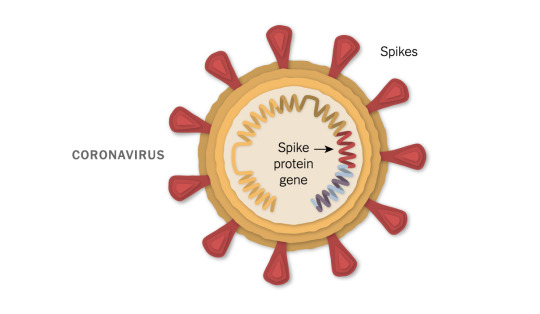
Like the Moderna vaccine, the Pfizer-BioNTech vaccine is based on the virus’s genetic instructions for building the spike protein.
mRNA Inside an Oily Shell
The vaccine uses messenger RNA, genetic material that our cells read to make proteins. The molecule — called mRNA for short — is fragile and would be chopped to pieces by our natural enzymes if it were injected directly into the body. To protect their vaccine, Pfizer and BioNTech wrap mRNA in oily bubbles made of lipid nanoparticles.
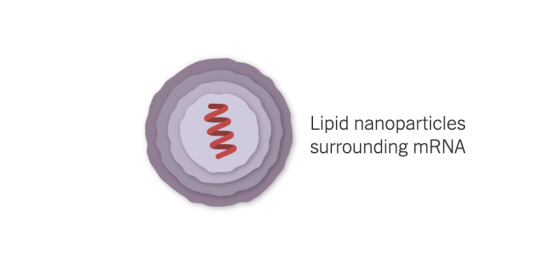
Because of their fragility, the mRNA molecules will quickly fall apart at room temperature. Pfizer is building special containers with dry ice, thermal sensors and GPS trackers to ensure the vaccines can be transported at -94 degrees Fahrenheit to stay viable.
Entering a Cell
After injection, the vaccine particles bump into cells and fuse to them, releasing mRNA. The cell’s molecules read its sequence and build spike proteins. The mRNA from the vaccine is eventually destroyed by the cell, leaving no permanent trace.
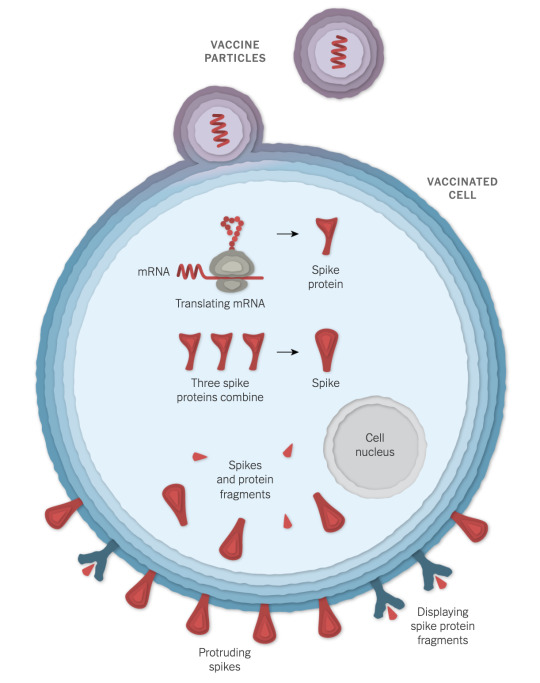
Some of the spike proteins form spikes that migrate to the surface of the cell and stick out their tips. The vaccinated cells also break up some of the proteins into fragments, which they present on their surface. These protruding spikes and spike protein fragments can then be recognized by the immune system.
Spotting the Intruder
When a vaccinated cell dies, the debris will contain many spike proteins and protein fragments, which can then be taken up by a type of immune cell called an antigen-presenting cell.

The cell presents fragments of the spike protein on its surface. When other cells called helper T-cells detect these fragments, the helper T-cells can raise the alarm and help marshal other immune cells to fight the infection.
Making Antibodies
Other immune cells, called B-cells, may bump into the coronavirus spikes and protein fragments on the surface of vaccinated cells. A few of the B-cells may be able to lock onto the spike proteins. If these B-cells are then activated by helper T-cells, they will start to proliferate and pour out antibodies that target the spike protein.
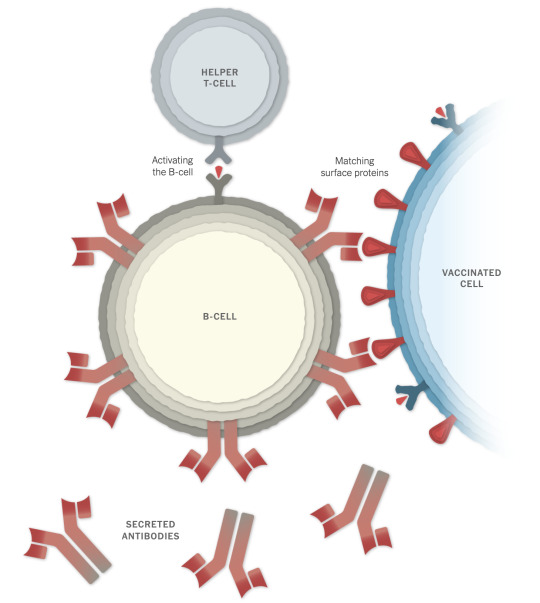
Stopping the Virus
The antibodies can latch onto coronavirus spikes, mark the virus for destruction and prevent infection by blocking the spikes from attaching to other cells.
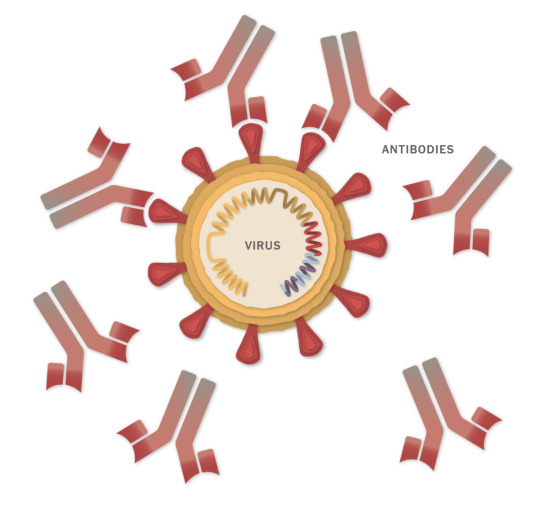
Killing Infected Cells
The antigen-presenting cells can also activate another type of immune cell called a killer T-cell to seek out and destroy any coronavirus-infected cells that display the spike protein fragments on their surfaces.
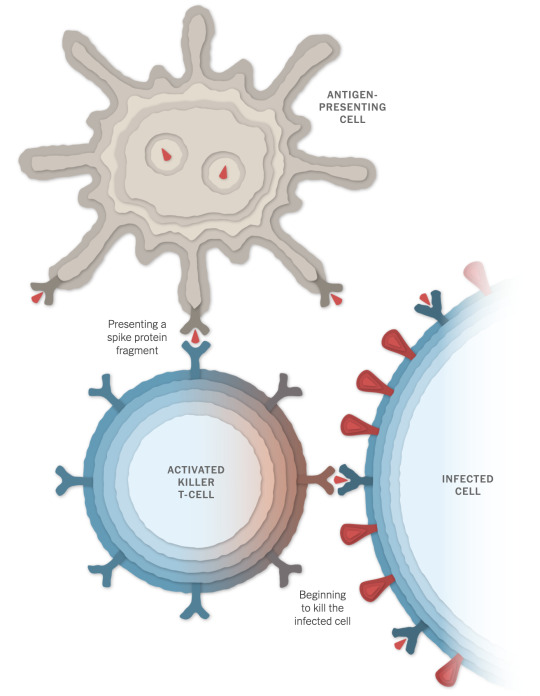
Remembering the Virus
The Pfizer-BioNTech vaccine requires two injections, given 21 days apart, to prime the immune system well enough to fight off the coronavirus. But because the vaccine is so new, researchers don’t know how long its protection might last.
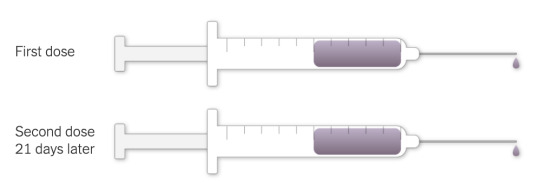
It’s possible that in the months after vaccination, the number of antibodies and killer T-cells will drop. But the immune system also contains special cells called memory B-cells and memory T-cells that might retain information about the coronavirus for years or even decades.
For more about the vaccine, see Pfizer’s Covid Vaccine: 11 Things You Need to Know.
Vaccine Timeline
January, 2020: BioNTech begins work on a vaccine after Dr. Ugur Sahin, one of the company’s founders, becomes convinced that the coronavirus will spread from China into a pandemic.
March: BioNTech and Pfizer agree to collaborate.
May: The companies launch a Phase ½ trial on two versions of a mRNA vaccine. One version, known as BNT162b2, had fewer side effects.
July 22: The Trump administration awards a $1.9 billion contract for 100 million doses to be delivered by December, with an option to acquire 500 million more doses, if the vaccine is authorized by the Food and Drug Administration.
July 27: The companies launch a Phase 2/3 trial with 30,000 volunteers in the United States and other countries, including Argentina, Brazil and Germany.
Sept. 12: Pfizer and BioNTech announce they will seek to expand their U.S. trial to 44,000 participants.
Nov. 9: Preliminary data indicates the Pfizer vaccine is over 90 percent effective, with no serious side effects. The final data from the trial shows the efficacy rate is 95 percent.
Nov. 20: Pfizer requests an emergency use authorization from the F.D.A.
Dec. 2: Britain gives emergency authorization to Pfizer and BioNTech’s vaccine, becoming the first Western country to give such an approval to a coronavirus vaccine.
Dec. 10: The F.D.A. will meet in an open session to discuss emergency authorization of the Pfizer-BioNTech vaccine.
Dec. 31: Pfizer expects to produce up to 50 million doses by the end of the year, and up to 1.3 billion doses in 2021. Each vaccinated person will require two doses.
Spring 2021: Vaccines by Pfizer and Moderna are expected to reach large-scale distribution in the spring.
Sources: National Center for Biotechnology Information; Nature; Florian Krammer, Icahn School of Medicine at Mount Sinai. By Jonathan Corum and Carl Zimmer (The New York Times).
2K notes
·
View notes
Photo





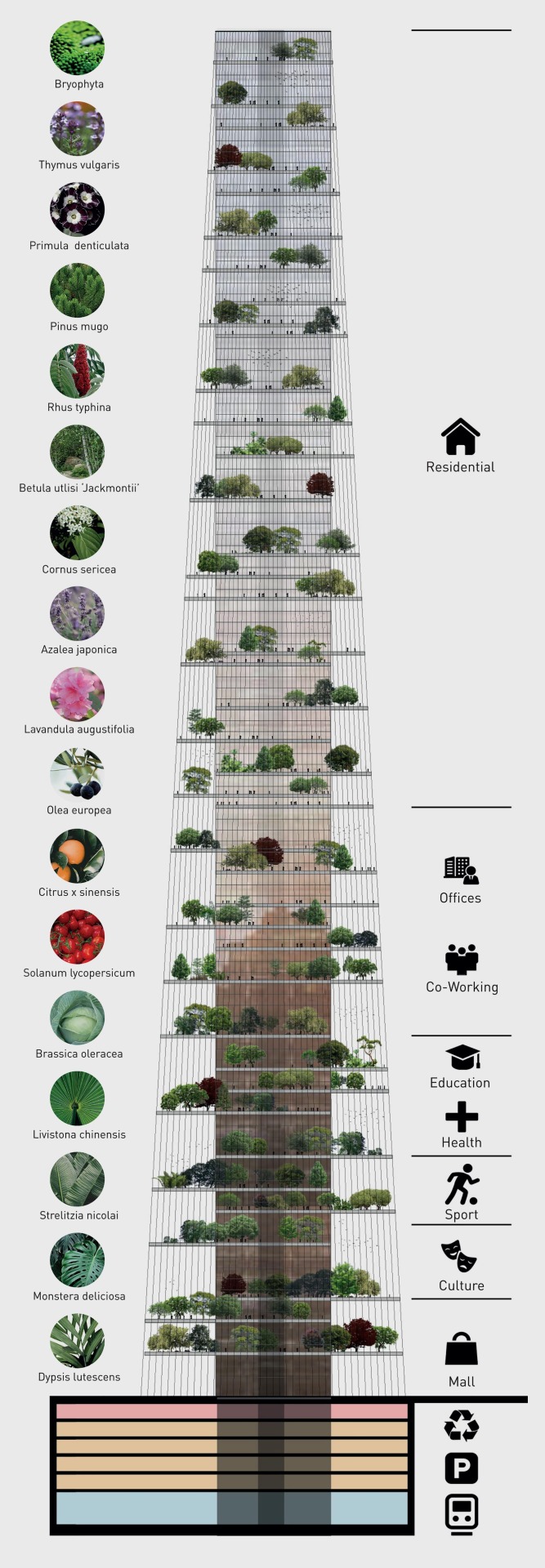

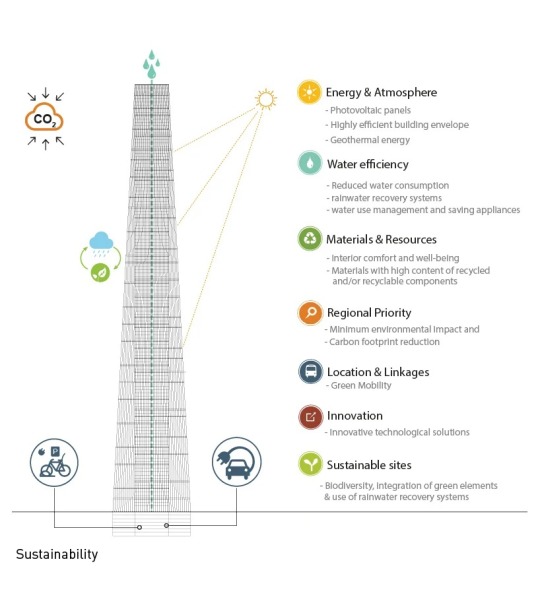
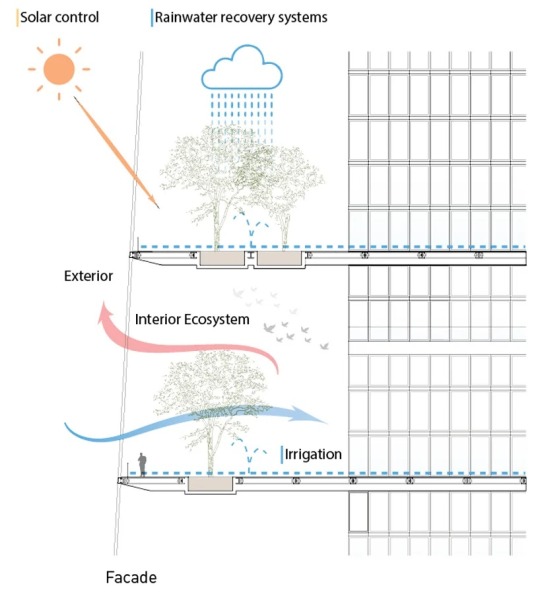
‘Skylines,’ New York, United States,
Lissoni Casal Ribeiro for Skyhive 2020 skycraper Challenge
Inspired by nature, the concept proposes a complete, self-sufficient ecosystem. the multi-use tower collects rainwater and gathers energy from the sun and the wind, transforming it from its tensioned cables into electricity to be used by inhabitants.
11K notes
·
View notes
Link
If you wanna think about language and gender and how we can improve society, check out Part I of my series on false gender dichotomies!! Parts II and III coming soon :)))
11 notes
·
View notes
Photo


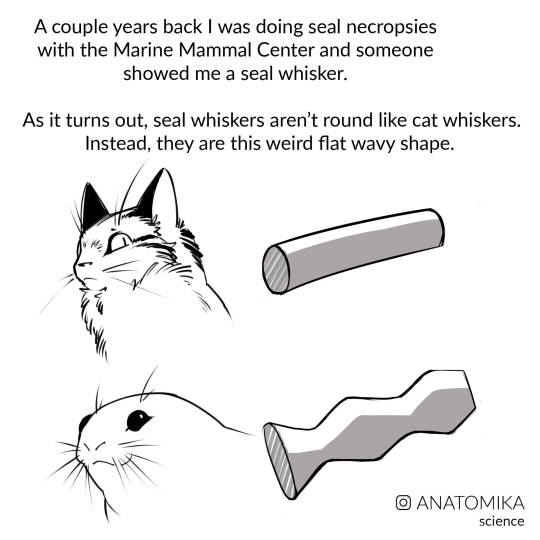
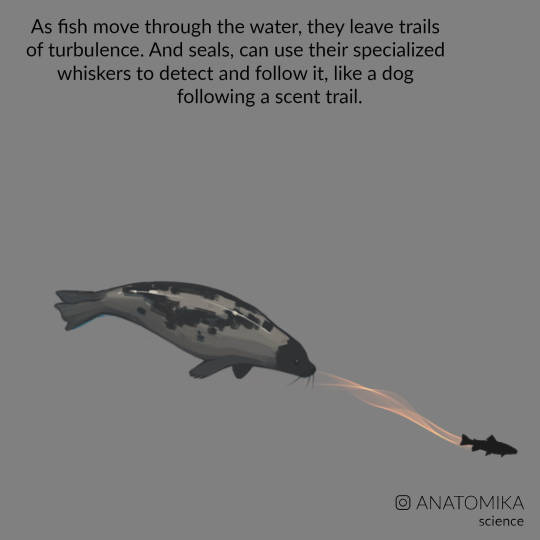


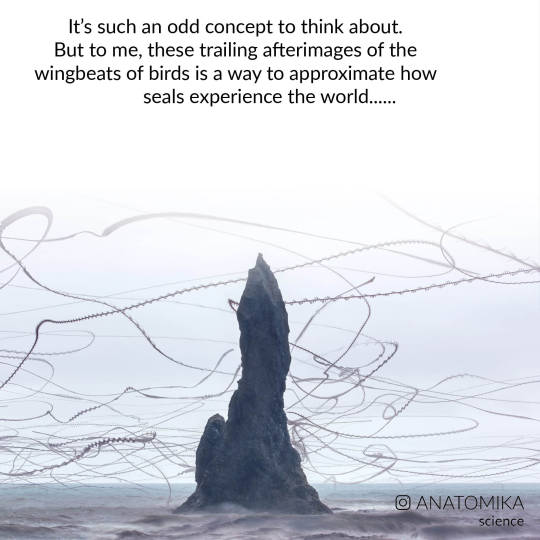

I think it’s incredible how seals experience the world.
Many of the deep-diving seals can go blind during their lifetime and live just fine.
Round whiskers flap around in the water and create their own turbulence, but the specific whisker shape they have cancels turbulence, so they can pinpoint trails of turbulence from prey. Other places to see my posts: INSTAGRAM / FACEBOOK / ETSY / KICKSTARTER
89K notes
·
View notes
Photo

On this day, 6 December 1989, 14 women, most of whom were training in engineering fields, were murdered in a mass shooting at the École Polytechnique in Montreal. The 25 year old shooter specifically targeted women, claimed he was “fighting feminism,” and killed himself after shooting 28 people. The victims’ names were: Geneviève Bergeron, Hélène Colgan, Nathalie Croteau, Barbara Daigneault, Anne-Marie Edward, Maud Haviernick, Maryse Laganière, Maryse Leclair, Anne-Marie Lemay, Sonia Pelletier, Michèle Richard, Annie St-Arneault, Annie Turcotte, and Barbara Klucznik-Widajewicz. The day is commemorated annually across Canada as the National Day of Remembrance and Action on Violence Against Women. https://www.facebook.com/workingclasshistory/photos/a.296224173896073/1284634265055054/?type=3
646 notes
·
View notes
Text
That makes me so happy! I love yours too; I've been following for a long time :)
e-n-t-p replied to your post “Hey Julia, I’m a second semester freshman right now but I think…”
Thank you so much ������
you’re welcome!!! keep being awesome!
also i am in LOVE with your blog :O
3 notes
·
View notes
Video
tumblr
In the wild, Lycoperdon pyriforme relies on agitation from animals or raindrops to spread its spores. Here is a (slow motion) video I took of the dispersion when pressure is applied. The genus Lycoperdon elegantly translates to “wolf’s flatulance.”
39 notes
·
View notes
Photo










Crucibulum laeve, common bird’s-nest fungus
The macro club project (Fungi - Mushrooms)
#mycology#bird's nest fungus#these things are sick#the eggs are like bags of spores that get catapulted out of the cup and release all the bbys
289 notes
·
View notes
Link
“I am glad I ignored the many people who told me that I could not be an astronomer.” Rest in peace, Dr. Roman.
(happened last month, but slipped by me!)
947 notes
·
View notes
Photo

This tweet from scientist Jacquelyn Gill (@JacqelynGill) went viral, and for good reason. The war on science continues, and she summed up this story perfectly into 3 sentences on Twitter.
Read the full article: http://bit.ly/2AxVBf3
Take action to keep standing up for science: http://bit.ly/2gOFm5N
91K notes
·
View notes
Text

Merry Christmas and Happy Holidays, scientists!
5K notes
·
View notes
Photo


What
21K notes
·
View notes
Video
tumblr
Introducing Ohio State's first ever iGEM team! We are a group of undergraduates from diverse majors trying to make a difference to cancer patients, fight antibiotic resistance, and advance the field of synthetic biology. Our indiegogo campaign is now live. Please consider contributing, any size donation helps us realize our team, research, and outreach goals ⚛️
#research#science#biology#chemistry#Cancer Research#antibiotics#public health#undergraduate research#STEM#scientists on tumblr#crowdfunding#campaign#donate
8 notes
·
View notes
Text
Is Rupi Kaur real or is she just an ad campaign made by urban outfitters
486 notes
·
View notes

